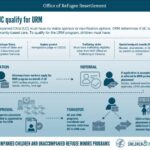Child labor trafficking is an important area of concern for service providers who support Unaccompanied Refugee Minors (URMs). Due to their unique circumstances, children and youth enrolled in the URM program may be at increased risk for labor trafficking. URM agencies are community-based service providers with connections to child welfare, law enforcement, local schools, and other service providers, so they are also in a good position to identify potential victims and survivors of trafficking in the community. This blog post is intended to equip URM service providers and other youth-serving professionals with key information and resources on this topic.
Defining Child Labor Trafficking
There are nuanced differences between legal child employment, labor exploitation, child labor, and child labor trafficking, which can be challenging to navigate.
The Trafficking Victims Protection Act (TVPA) of 2000 defines labor trafficking as “the recruitment, harboring, transportation, provision, or obtaining of a person for labor or services through the use of force or fraud or coercion for the purposes of subjection to involuntary servitude, peonage, debt bondage, or slavery” (emphasis ours). The force, fraud, or coercion requirement of labor trafficking is particularly important when distinguishing among legal child employment, labor exploitation, child labor, and child labor trafficking:
- Although employment laws vary by state and industry, children are typically allowed to work legally when they are between 14 and 16 with permission of their parent or guardian. This situation is legal child employment.
- If children are working legally but are denied basic legal rights (such as fair compensation, appropriate hours, or overtime), they are experiencing labor exploitation.
- In contrast, if minors under the legal working age are engaging in illegal work and/or work that is harmful to their health, development, or education, this situation constitutes child labor.
- Child labor trafficking can have many of the same components as labor exploitation and child labor but is only considered labor trafficking if force, fraud, or coercion is present. In child labor trafficking, force involves physically restraining or harming a child. Fraud involves intentionally deceiving a child regarding certain aspects of their employment, such as job duties, work conditions, and payment. Coercion involves threats of serious psychological or physical harm to the child or their loved ones and can include real or threatened abuse of the legal system.
Adapted from Child Labor Trafficking, Office of Juvenile Justice and Delinquency Prevention, 2016
What Can Child Labor Trafficking Look Like?
- Places where children can experience trafficking vary widely and can include farms or agricultural settings, homes or domestic settings, beauty salons, cleaning companies, hospitals, hotels, retail settings, and athletic centers. Labor trafficking can take place outside of formal work environments and can involve illegal activities like drug dealing or theft.
- Traffickers can be connected with a child through a wide range of relationships: family members, caregivers (including sponsors, community supporters, foster family members, house parents, and others), employers or other people in the workplace, friends, romantic partners, religious community members, or educational or sports faculty. Remember that a trafficker may be someone whom the child being victimized knows and cares about.
- Victims and Survivors of child labor trafficking may be of any age, sex, race, ethnicity, ability, immigration status, sexual orientation, or socio-economic background. Children born outside of the U.S., children who have experienced trauma, and children who lack robust support systems may be at greater risk for trafficking.
Switchboard’s archived webinar Safety Planning with Unaccompanied Refugee Minors offers case scenarios that can help you recognize potential labor trafficking situations among URM clients.
Considerations for Providers Serving Unaccompanied Refugee Minors (URMs)
If you are a service provider who supports URMs, there are concrete steps you can take related to labor trafficking:
- Be aware of labor trafficking warning signs. Signs that may indicate child labor trafficking include missing school to work, confusing or contradictory stories about their work, fear of speaking about work, concerns about money or well-being of family back home, heavily monitored or controlled behavior, or disheveled appearance. See Additional Resources, below, to learn more.
- Openly discuss work with URM clients. Share age-appropriate information on U.S. laws and regulations around child labor, what their rights are as youth, and whom to talk to if they feel they are experiencing trafficking. When talking with youth about employment, keep an open mind and avoid assumptions. Remember that work looks different in cultural contexts around the world, and adjusting to U.S. work culture may be a long process. Cultural norms around age-appropriate work, familial pressure to work, and a youth’s own desire to work can all be important considerations.
- Prioritize safety planning within the scope of your role. Switchboard’s archived webinar Safety Planning with Unaccompanied Refugee Minors reviews warning signs for labor and sex trafficking among URMs; components of a strong safety plan; when and how to develop a safety plan with URM clients (if this is within your scope); and how to partner with community providers with various areas of expertise, like certified domestic violence shelters, homeless/runaway youth programs, and LGBTQI+ youth programs.
- Connect with labor trafficking service providers. You do not need to be an expert on trafficking to support your clients. The National Human Trafficking Hotline offers 24/7 confidential reporting and a directory of anti-trafficking organizations that provide emergency, transitional, or long-term services to victims and survivors of human trafficking. Anti-trafficking organizations in your state can advise on reporting requirements and state clearinghouses. For recommendations on a multidisciplinary task force approach to anti-trafficking, see the Office for Victims of Crime (OVC) Task Force Guide.
- Explore benefits and services for youth who have experienced trafficking. Newcomer minor victims and survivors of trafficking may be eligible for a Child Eligibility Letter provided by the Office of Trafficking in Persons (OTIP). These letters allow minors to access public services and many of the same protections and benefits as refugees—such as medical services, food assistance, cash assistance, health insurance, and additional supports. For instance, newcomer minor victims and survivors of trafficking who are not in the care of a parent or legal guardian and receive a Child Eligibility Letter may be eligible to enter the Unaccompanied Refugee Minors (URM) program. Providers can find information on the process for requesting an eligibility letter on OTIP’s website. Note that an eligibility letter is not a form of immigration relief but may aide the minor in establishing legal relief.
- Take a survivor-centered and trauma-informed approach. Trauma manifests itself in many ways, and services must meet the client where they are. Work to give victims and survivors a sense of agency to help restore their sense of self. This can be particularly challenging when working with minors because they cannot legally make certain decisions. Strive for balance in letting minors make decisions for themselves where they can, while requiring them to follow certain guidelines for their safety and well-being. Giving options that are within reason and legal bounds is one way to do this. Another is to assess whether a client would benefit from a Child Advocate.
The Department of Health and Human Services Office of Refugee Resettlement (ORR) provides independent child advocates to certain especially vulnerable children pursuant to the Trafficking Victims Protection Reauthorization Act (TVPRA). Child advocates identify and advocate for the best interests of individual children. They provide best interests recommendations to decisionmakers on matters related to custody, placement, reunification with family, permanency, release, and repatriation of a child. In limited circumstances, ORR may consider initial child advocate appointments for unaccompanied children placed in the URM program if there are existing vulnerabilities and needs, such as trafficking concerns. Referrals for child advocate services may be made through the Young Center, the current child advocate contractor.
Additional Resources
Anti-Labor Trafficking Resources Relevant to Children and URMs
- The Young Center’s Technical Assistance Program (TAP) offers culturally sensitive and trauma-informed consultations, mentorship, trainings, and resources to professionals working with immigrant children in state court systems. You may request a consultation about a child in a suspected labor trafficking situation and/or how to engage child protective services in such a situation by filling out this form.
- The U.S. Committee for Refugees and Immigrants (USCRI) provides resources geared toward child victims and survivors of trafficking, including three specific toolkits: Safety Planning with Foreign National Children and Youth Survivors of Trafficking, Trauma-Informed Case Management with Foreign National Children and Youth Survivors of Trafficking, and Special Considerations for Foreign National Children and Youth Survivors of Trafficking.
- HEAL Trafficking provides a useful infographic illustrating the differences and similarities between child labor, labor trafficking, and labor exploitation
- This OTIP child eligibility handout describes various benefits and services that may be available to minors who have received a Child Eligibility Letter
- The Child & Family Policy Institute of California provides a tool for identifying and responding to child labor trafficking that includes a list of warning signs and a labor trafficking quick screener
- The National Center on Safe Supportive Learning Environments offers detailed information on certain youth populations that are especially vulnerable to being trafficked
Anti-Labor Trafficking and Healthy Labor Practices Resources
- OTIP provides a labor trafficking fact sheet that includes definitions of various forms of labor trafficking along with tips for identifying and assisting victims and survivors
- The U.S. Department of Labor hosts the YouthRules! initiative, which promotes positive and safe work experiences by educating teens and their caregivers on federal and state labor laws for young workers
- The Youth Employment Compliance Assistance Toolkit is a resource developed by the U.S. Department of Labor that provides five specific tools to help employers ensure they are following laws and regulations surrounding youth employment
- Framework was a platform funded by the Office for Victims of Crime (OVC) that provided resources and training to service providers and community partners assisting victims and survivors of labor trafficking. Their multimedia library offers a wealth of archived resources.
General Anti-Trafficking Resources
- The Office for Victims of Crime (OVC) is the largest funder of anti-trafficking programming in the country and supports a broad array of programs and services that focus on helping victims and survivors in the immediate aftermath of crime and as they rebuild their lives
- The National Human Trafficking Training and Technical Assistance Center offers information and resources for providing culturally and linguistically appropriate responses when working with victims and survivors of trafficking
- The Office on Trafficking in Persons (OTIP) provides information and resources about human trafficking, including a list of signs that someone may be experiencing trafficking
- Polaris Project offers a fact sheet outlining the Action-Means-Purpose (A-M-P) Model for identifying whether a particular situation would meet the federal definition of human trafficking
- The National Human Trafficking Resource Center and Polaris provide a comprehensive trafficking assessment tool, which includes questions related to labor trafficking in general as well as within specific industries
- Switchboard’s blog post On World Day Against Trafficking, a Resource List of Anti-Trafficking Resources highlights anti-trafficking resources for providers working to serve children and youth, prevent trafficking, assist victims and survivors, and spread awareness









